Elemental Chlorine-Free (ECF):
Pollution Prevention for the Pulp and Paper Industry
Submission to
the Joint Standing Committee on Natural Resources
118th Maine Legislature
April 1997
Douglas C. Pryke, Executive Director
Washington, D.C. and Erin, Ontario
ABSTRACT
Elemental Chlorine-Free (ECF) pulp, bleached with chlorine dioxide, continues to dominate the world bleached chemical pulp (BCP) market. By the end of 1997, ECF production will be 38 million tonnes, totaling 50% of the world market share.
The rapid growth of ECF is being driven partly by regulation, but mostly by market demand. The rapid acceptance of ECF pulp in the U.S. market is recognition of ECF as a pollution prevention technology that complies with the statutory intent and definitions of the U.S. "Pollution Prevention Act of 1990."
ECF bleaching, while producing the highest quality pulp:
- Eliminates 2,3,7,8-TCDD and 2,3,7,8-TCDF to non-detect levels;
- Eliminates the 12 priority chlorophenols proposed by the U.S. Environmental Protection Agency (EPA) for regulation to non-detect levels;
- Decreases chloroform formation;
- Decreases chlorinated organic compound (AOX) formation by 90%;
- Efficiently utilizes forest resources;
- Contributes to eco-system recovery; and is
- Compatible with emerging minimum-impact mill technologies.
INTRODUCTION
Amid growing public and scientific debate about bleaching technologies, consensus is emerging around three important developments. First, chlorine dioxide, the cornerstone of ECF, is an environmentally superior bleaching agent. Second, chlorine dioxide is not a barrier to closing a mill's process water loop. Third, market growth is being driven by ECF. This consensus suggests that chlorine dioxide is not an interim technology, nor is it a transitional phase in the industry's quest for the minimum-impact mill.
The clear and urgent need to eliminate persistent, bio-accumulative, toxic substances in pulp and paper mill waste water has pushed the conversion to chlorine dioxide bleaching. But some feel this conversion is simply not enough. Two divergent approaches shape the public debate: ECF and Totally Chlorine-Free (TCF). The U.S. EPA's proposed Cluster Rule for the pulp and paper industry, which has ECF as one of its core Best Available Technology (BAT) elements, has sharpened the focus. This paper discusses why ECF is the consensus choice for pollution prevention technology for the bleached pulp and paper industry.
ENVIRONMENTAL PERFORMANCE
Chemistry
In chemistry, a single atom can make a world of difference. Chlorine dioxide's (ClO2) chemical properties are very different from those of molecular chlorine (Cl2) and they yield very different end results.
The chlorine dioxide molecule consists of one chlorine atom and two oxygen atoms. The oxidation level of the chlorine atom in chlorine dioxide is +4, while the oxidation level of the chlorine atom in molecular chlorine is +1. Based on reduction to chloride at an oxidation level of -1, there is a change of five oxidation levels with chlorine dioxide compared to two for chlorine. Chlorine dioxide therefore has 2-1/2 times the oxidation potential.
These differences make chlorine dioxide not only a superior bleaching agent, but one with distinct environmental benefits. During the pulp bleaching process, both chlorine and chlorine dioxide can form chlorinated organics. However, whereas chlorine tends to substitute and combine with lignin -- the substance that holds the wood fibers together -- chlorine dioxide typically oxidizes the lignin, opening up the aromatic structure. Any remaining chlorinated organics formed by ClO2 bleaching are water soluble and do not bio-accumulate. Instead, they are very similar to chemical substances occurring naturally in the environment [1].
Complementing its oxidizing strength is its selectivity. ClO2 attacks lignin and other substances such as resins, while preserving the wood's cellulose fibers -- those that provide the strength in the final paper products.
Dioxin, Furan, and Polychlorinated Phenolics
Elemental Chlorine-Free, ECF, based on chlorine dioxide, is pollution prevention. It is well documented that increasing chlorine dioxide substitution eliminates 2,3,7,8-TCDD and 2,3,7,8-TCDF to non-detect levels [2,3]. Mill experience, shown in Figure 1, confirms laboratory investigations.
Final Mill Effluent 2,3,7,8-TCDD/F TEQ vs. Chlorine Dioxide Substitution
Potlatch Corp., Cloquet, Minnesota
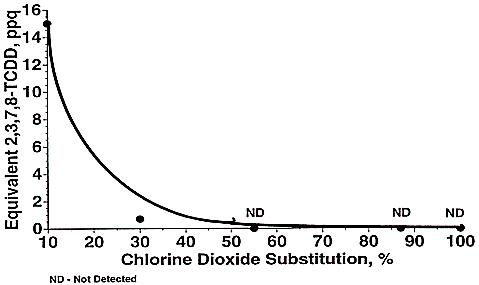
Increasing chlorine dioxide substitution decreases the formation of polychlorinated phenolic compounds. As shown in Figure 2, with 100% substitution, tri-, tetra-, and pentachlorinated phenolics are not detected [4].
Elimination of Polychlorinated Phenolics vs. ClO2 Substitution

These results for dioxin, furan, and polychlorinated phenolic compounds were recently confirmed in a study of seven Canadian bleached kraft pulp mills operating ECF. The conclusions of that study were [5]:
"Data generated in this study support earlier research that indicates 2,3,7,8-TCDD, 2,3,7,8-TCDF and twelve highly substituted chlorinated phenolic compounds are not detected above analytical minimum levels in bleach plant effluents from mills which operate using complete chlorine dioxide substitution."
Chlorinated Organic Compounds
Complete replacement of chlorine with chlorine dioxide decreases formation of chlorinated organic compounds, as measured by the group parameter AOX (Adsorbable Organic Halogens), by 80-90%. The chlorinated organic compounds produced are characterized by high water solubility, low chlorine to carbon ratio, low aromaticity, and non-bioaccumulation. In fact, they are very similar to naturally occurring chlorinated humic materials [1]. A recent ecological risk assessment of the chlorinated organic compounds produced with ECF bleaching reached the following conclusions [6]:
"The environmental risks from chlorinated organics are insignificant at mills bleaching with chlorine dioxide, employing secondary treatment, and with receiving water dilutions typically found in North America."
Eco-System Response
As previously discussed, mills implementing ECF have eliminated dioxin and furan in mill effluent to non-detect levels. Consequently, downstream of North American pulp and paper mills, dioxin levels in fish tissue have significantly declined.
The Weyerhaeuser Canada Ltd. market kraft pulp mill in Grande Prairie, Alberta, converted the bleaching process initially to 70% chlorine dioxide substitution in late 1990. In 1992, the mill switched entirely to ECF. The impact of increased chlorine dioxide substitution on dioxin concentration in mill effluent is shown in Figure 3 [7]. The data show that as chlorine dioxide substitution was increased, dioxin was eliminated to non-detect levels in mill effluent.
Chlorine Dioxide Substitution vs. Dioxin Levels in Mill Effluent,
Weyerhaeuser Canada, Grande Prairie, Alberta
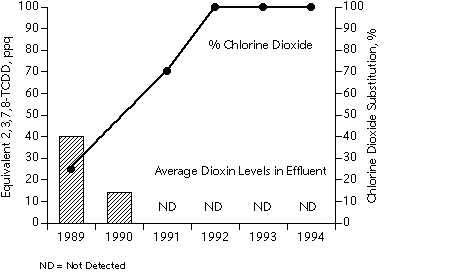
Similarly, dioxin in mountain whitefish dropped to levels comparable to reference sites where no pulp and paper mills are located and now remains consistently below Health and Welfare Canada's human consumption guideline of 20 ppt TEQ (Fig. 4).
Wapiti River Mountain Whitefish Dioxin (TEQ), 1990-1994
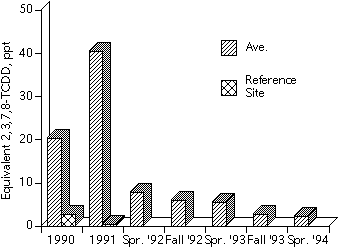
Eco-System Response in Maine
As mills in Maine have increasingly replaced chlorine with chlorine dioxide and moved toward ECF, dioxin in mill discharges has declined [8] (Fig.5).
Average Maine Bleach Kraft Mill Discharge
parts per quadrillion, ppq
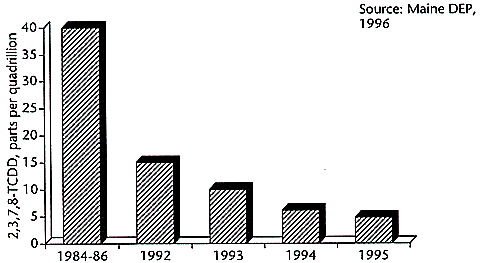
Similarly, dioxin in fish tissue has declined. For example, in the Penobscot River (Veazie sampling station), the dioxin in Suckers (whole fish) has consistently declined year after year (Fig. 6) [9].
Dioxin in Maine Fish, ppt,
(Suckers, whole fish) Penobscot River, Veazie
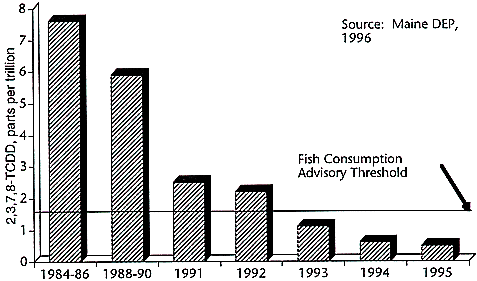
Lifting of Fish Advisories
State health and environmental departments issue fish consumption advisories or bans to protect sport and subsistence anglers, and the general public, from the risk of consuming locally caught, contaminated fish. Fish consumption advisories are based on factors such as contamination levels of specific target chemicals, which include, among others, dioxin, mercury, PCB's (polychlorinated biphenyls), and various pesticides. As such, advisories are one indicator of the environmental status of a particular aquatic eco-system, for example a lake, bay, or river. Removing or partially rescinding a fish consumption advisory or ban generally signals positive change in the aquatic eco-system under study.
An analysis of the U.S. Environmental Protection Agency's National Listing of Fish and Wildlife Consumption Advisories (NLFWCA) and state environmental and health authority data, reveals an important finding regarding fish consumption advisories for dioxin [10]. As a result of actions similar to the Weyerhaeuser Canada mill on the Wapiti River and in Maine, the small number of waterbodies under a dioxin advisory is steadily diminishing. Since 1990, 13 states have lifted a total of 17 dioxin advisories from waterbodies downstream of U.S. pulp mills.
The EPA's proposed Cluster Rule is based on Best Available Technology. For the bleached paper grade kraft sector, BAT has ECF as one of it core elements. EPA has analyzed the remaining dioxin advisories downstream of pulp mills in the U.S. using the Dioxin Reassessment Evaluation model approach. EPA's analysis showed that following implementation of the proposed guidelines, all remaining dioxin advisories downstream of pulp mills would be lifted, as shown in Figure 7 [11].
Liftings of U.S. Fish Consumption Dioxin Advisories Downstream of Pulp Mills
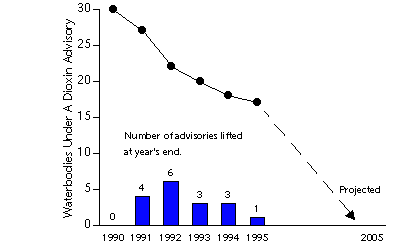
Effluent Quality
Numerous studies have recently investigated the quality of bleaching effluents from ECF and TCF processes [12-15]. The general conclusion from each of these studies is that the differences in toxicity in a wide variety of test species are not significant, and the secondary biological treatment removes toxicity from the effluents. Conclusions reached were:
- "...it may be concluded that no clearcut differences in biological
effect-inducing potential was found between effluents from production of
ECF-pulp and TCF-pulp. As a final conclusion, it may thus be stated that the
overall effect picture was weak and no significant differences in the power
to produce long-term toxicity at the ecosystem level was demonstrated
between the effluents from the two bleaching concepts...[13]"
"...A comparison of the toxic responses of bleach plant and whole mill effluents from mills using different schemes for non-chlorine bleaching, i.e., ECF versus TCF bleaching, shows that neither technical concept invariably produces effluents with lower toxic potency. Thus, according to studies made to date, ECF and TCF bleaching are not possible to separate in terms of their potential to produce detrimental effects in the aquatic ecosystem...[14]"
"There is no appreciable environmental difference between TCF and ECF [15]."
Pollution Prevention
The U.S. Pollution Prevention Act of 1990 (the "Act") recognized that, "... there are significant opportunities for industry to reduce or prevent pollution at the source through cost-effective changes in production, operation, and raw materials use...[16]." The Act also acknowledged that "... source reduction is fundamentally different and more desirable than waste management and pollution control...".
Though "pollution prevention" is not specifically defined, the Act makes clear that "pollution prevention" incorporates the concepts of both preventing and reducing the formation of pollution.
The Act defines the term "source reduction" as any practice that:
- reduces the amount of any hazardous substance, pollutant, or contaminant entering any waste stream or otherwise released into the environment; and
- reduces the hazards to public health and the environment that are associated with the release of such substances, pollutants, or contaminants.
Source reduction may include equipment or technology modifications, process or procedure modifications, reformulation or redesign of products, and substitution of raw materials.
On the basis of the demonstrated pollution prevention and source reduction discussed above, it is clear that complete substitution of chlorine dioxide complies with the statutory intent of "Pollution Prevention."
North American Regulatory Forces
On December 17, 1993, the U.S. EPA proposed revised effluent limitations and pretreatment guidelines for all pulp, paper, and paperboard mills. EPA is expected to promulgate final regulations in 1997, with compliance within three years of enactment [17].
Regulations by EPA are developed using Best Available Technology guidelines. Recognizing that complete substitution of chlorine dioxide, ECF, is pollution prevention, EPA's BAT guidelines for the largest pulp, paper, and paperboard subcategory -- the bleached papergrade kraft sector -- are based on ECF. EPA is proposing non-detect limits at the bleach plant for tetrachlorodibenzo-p-dioxin (TCDD) and twelve chlorophenolics (tri-, tetra-, and penta-substituted), and numerical limits for tetrachlorodibenzo-p-furan (TCDF), and chloroform. EPA has also proposed a number of guidelines for "non-conventional" pollutants. Specifically, AOX limits are proposed for final effluents from bleached kraft and sulfite mills.
QUALITY, YIELD, AND COST FACTORS INFLUENCING GROWTH OF ECF
Pulp Quality
Market pulp quality from ECF bleaching is excellent. Mill studies in Canada and the U.S. have shown high brightness, 89-90% ISO, and high strength (burst, tear, tensile, viscosity) are produced with ECF [7,18,19]. Today's TCF sequences are less selective than ECF and consequently have been unable to retain high strength values at full brightness.
A number of recent studies have shown that TCF tear strength at high brightness is 10% lower than ECF and the pulps have lower fiber strength [20-24]. The lower strength has implications for paper machine productivity and virgin fiber requirements in recycled grades and recyclability [25].
Yield
ECF production does not require low lignin content of unbleached pulps and therefore has higher yield than today's TCF pulping and bleaching processes. Recent studies show TCF bleaching of 8 kappa number pulp increases overall wood consumption up to 10% as compared to an ECF bleaching of 30 kappa number pulp [26-28]. In a recent tour of Scandinavian mills, mill experience confirmed the yield loss:
"Wisaforest [Finland] claims it requires 6% more wood to make a ton of TCF pulp than ECF pulp. This was confirmed at the Enocell [Finland] mill. All of the mills that produced any TCF pulp noted its lower strength properties [29]."In North America, if the industry converted to TCF, an additional harvest of 100 million trees would be necessary to produce the same amount of pulp. An additional 5 million trees would be necessary if the mills in Maine converted to TCF.
Capital and Operating Cost
In any estimate of capital and operating costs to convert to new technology, the reference case must be taken into account. For existing mills, conversion to ECF has been relatively easy for the following reasons:
- many mills had existing chlorine dioxide generators that could be upgraded to the required production for relatively low capital cost;
- existing bleach plants were totally compatible; and
- bleaching cost increased modestly, 5-10%.
However, conversion to TCF, as shown in Figure 8, is relatively difficult for most existing mills for the following reasons:
- the capital cost to convert ranges from $40 million-$190 million U.S. [30,31];
- operating costs increase $20-$75 U.S. per ton [30,31]; and
- existing bleach plants have insufficient retention time for efficient hydrogen peroxide bleaching.
Capital and Operating Costs Estimates
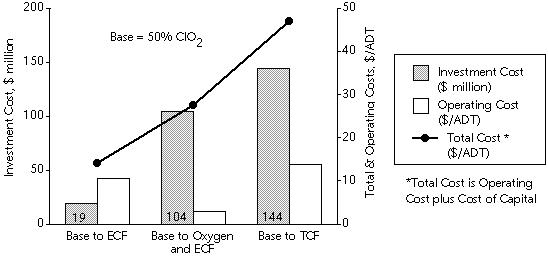
These estimates in operating cost increases have been recently confirmed in analyses by mills that produce both ECF and TCF. An Austrian mill which recently modernized its bleach plant to produce ECF determined that the incremental bleaching cost for TCF would be $60 U.S. per ton [32].
A large producer of both ECF and TCF, based on real mill experience, recently stated:
- "The results show that it [relative bleaching cost] is 60% more
expensive at full brightness (>88% ISO) and 16% more at 86% ISO
brightness, respectively with TCF compared to ECF [24]."
TRENDS IN BLEACHED CHEMICAL PULP (BCP) PRODUCTION
World BCP Production Profile
Worldwide, ECF manufacture dwarfs TCF. In 1997, ECF will command the highest worldwide market share at 50%, totaling 38 million tonnes [33]. This marks a 12% production increase from 1996. ECF market share continues to grow in all producing regions including Canada, the U.S., Chile, Brazil, Japan, Southeast Asia, Africa, Australia, and New Zealand.
Market data show a widening gap between ECF and TCF production. ECF continues to grow, with an additional 4 million tonnes entering the market in 1997. TCF, which occupies a small Northern European niche, remains steady at 6% of the world market (Fig. 9). No production increase is expected for TCF in 1997.
World Bleached Chemical Pulp Production
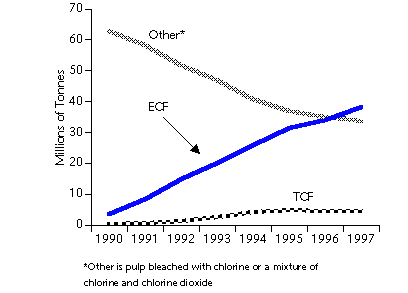
Scandinavia
In Scandinavia, ECF demand remains strong, accounting for 75% of bleached chemical pulp production -- triple that of TCF. The demand for TCF has stalled, and some producers are responding by shifting a greater percentage of their production to ECF. Signaling a turning point in Scandinavian pulp production, one of the largest TCF producers will increase production of ECF in 1997 [24].
Scandinavian Bleached Chemical Pulp Production
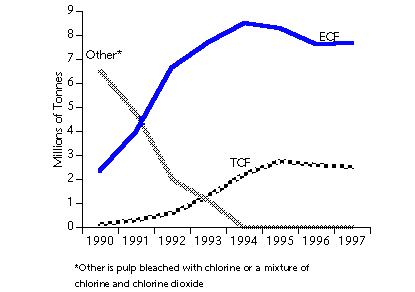
North America
In North America, ECF production will increase in 1997 by 16% to represent 55% of bleach chemical pulp production. In Canada, as shown in Figure 11, ECF production totals 8.7 million tonnes, approximately 70% of all Canadian BCP production. In contrast, TCF shows no signs of meaningful growth; production will remain at 40,000 tonnes, showing no growth during the last three years.
Canadian Bleached Chemical Pulp Production

In the U.S., ECF has taken off, and will reach 13 million tons in 1997, or 47% of U.S. BCP production (Fig. 12). TCF production lags far behind at barely 200,000 tonnes per year.
U.S. Bleached Chemical Pulp Production
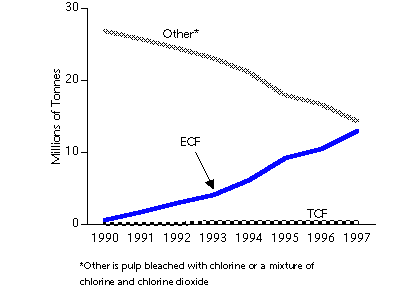
DRIVING FORCES TOWARD THE MINIMUM-IMPACT MILL OF THE FUTURE
Having developed and implemented a strategy for virtual elimination of persistent, bio-accumulative, and toxic compounds, research on the environmental responses to pulp mill effluent has shifted focus. Subtle responses such as the induction of liver enzymes in exposed fish are now the focus of attention in the scientific and technical communities. The ecological significance of such responses has yet to be determined.
Initially thought to be due to exposure to bleached pulp mill effluent, subsequent research has shown such subtle responses to be found both at bleached and unbleached pulp mills. Current research suggests the source may be natural wood extracts that are released into the environment during the processes that prepare the cellulose fibers prior to bleaching. Issues such as these subtle responses and industry's commitment to minimizing the environmental impact of papermaking are driving the development of minimum-impact mills.
One aspect of minimum-impact mills is minimizing waste water discharge. Taking inspiration from successful application of closed cycle processes for mechanical and semi-chemical pulp mills, current research and development is focusing on technologies to "close the loop" to an even greater degree than is presently practiced at bleached chemical pulp mills.
Pilot plant and demonstration processes for elimination of bleaching effluent are in operation at many facilities throughout the world. Processes are being developed for both ECF-based bleaching and TCF-based bleaching.
In the U.S., two demonstration projects may show the way for the future. At the Union Camp, Franklin, VA mill, the bleach plant effluent from the ozone and alkali extraction stages is being substantially recovered to the unbleached part of the mill, thereby decreasing the volume of effluent to be treated [34]. Champion International Corp's., Canton, NC, mill is a demonstration site for the company's new technology, Bleach Filtrate Recovery (BFR®), designed to virtually eliminate bleaching effluent. The process recovers effluent from an ECF bleach plant. Effluent is recycled to the unbleached part of the mill and excess sodium chloride removed via precipitation [35,36]. Comparable bleach plant effluent volume reductions are being achieved with both ECF- and TCF-based processes [36].
Recent estimates also show that for minimum-impact mills or "closed loop" systems, operating costs for ECF-based processes are favored over TCF-based systems as shown in Figures 13a & 13b [37,38].
Manufacturing Cost in Pulp Bleaching: Open Cycle
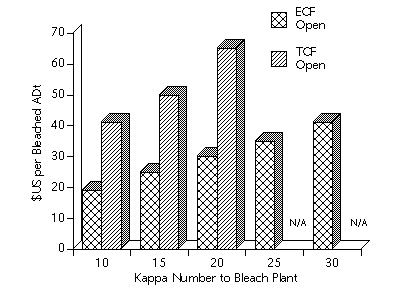
Manufacturing Cost in Pulp Bleaching: Closed Cycle
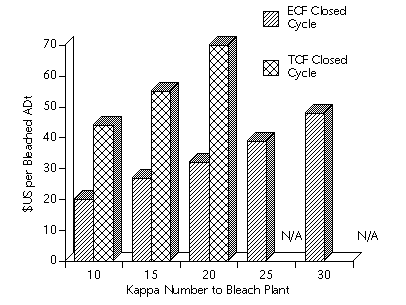
SUMMARY
Complete substitution of chlorine dioxide is pollution prevention. Environmental performance, superior product quality, favorable economics, future regulatory requirements, and the market demand fueling ECF's current rate of growth, assure its place as the dominant product in nearly every world market.
Implementation of ECF has allowed the pulp and paper industry to achieve not only pollution prevention, but also virtual elimination of dioxin, as witnessed by the decrease in fish dioxin body burdens and the accompanying lifting of advisories. As the industry looks toward the future, the success of process modifications, including ECF, has laid the foundation for future minimum-impact mills.
REFERENCES
- Dahlman, O., Reimann, A., Strömberg, L. and Mörck, R., "On the Nature of High Molecular Weight Effluent Materials from ECF- and TCF-Bleaching." Proceedings, International Pulp Bleaching Conference. June 1994.
- Berry, R.M., Fleming, B.I., Voss, R.H., Luthe, C.E. and Wrist, P.E., "Toward Preventing the Formation of Dioxins During Chemical Pulp Bleaching." Pulp & Paper Canada, 90:8 (1989).
- Pryke, D.C., "Five Great Reasons Why We Care: The Pulp and Paper Industry's Virtual Elimination Strategy." International Joint Commission 8th Biennial Meeting. September 1995.
- O'Connor, B.I., Kovacs, T.G., Voss, R.H., Martel, P.H. and van Lierop, B., "A Laboratory Assessment of the Environmental Quality of Alternative Pulp Bleaching Effluents." Pulp & Paper Canada, 95:3 (1994).
- "Characterization of Effluent Quality at Seven Canadian Bleach Kraft Pulp Mills Operating Complete Substitution Bleach Plants: A Cooperative Study with NCASI." National Council of the Paper Industry for Air and Stream Improvement. May 1995.
- Solomon, K., Bergman, H., Huggett, R., McKague, B. and Mackay, D., "A Review and Assessment of the Ecological Risks Associated with the Use of Chlorine Dioxide for the Bleaching of Pulp." Pulp & Paper Canada, 97(10) (1996).
- Pryke, D.C., Bourre, G., Swanson, S., Owens, W. and Kloepper-Sams, P., Environmental Improvements at Grande Prairie and Ecosystem Response." Pulp & Paper Canada, 96:11 (1995).
- Mower, B., "Dioxin Monitoring Program State of Maine 1995." Department of Environmental Protection. Augusta, Maine. July 1996.
- Ibid.
- Alliance for Environmental Technology, "Eco-System Recovery: Liftings of Fish Consumption Advisories for Dioxin Downstream of U.S. Pulp Mills." September 1996.
- U.S. EPA, "Regulatory Impact of Proposed Effluent Guidelines and NESHAP for the Pulp, Paper, and Paperboard Industry." November 1993.
- Nelson, P., Stauber, J.L., Gunthorpe, L., Deavin, J.G., Munday, B.L., Krassoi, R. and Simon, J., "Toxicity Testing of Effluents from ECF and TCF Bleaching of Eucalyptus Pulps." Proceedings, International Non-Chlorine Bleaching Conference. March 1995.
- Grahn, O. and Grotell. Swedish Environmental Research Group. "Effects in Model Ecosystems of Bleach Plant and Whole Mill Effluents from Production of TCF- and ECF-Bleached Softwood Kraft Pulp at the Södra Cell AB Mill Värö Bruk." September 1995.
- Tana, J. and Leftinen, K-J., "The Aquatic Environmental Impact of Pulping and Bleaching Operations - An Overview." Finnish Environmental Agency, Helsinki, (1006).
- "A Changing Future for Paper," International Institute for Environment and Development, commissioned by the World Business Council for Sustainable Development, 1996.
- Pollution Prevention Act of 1990. 42 USC 18101. Laws of 101st Congress -- 2nd Session.
- Federal Register Vol. 58 (241) pp. 66078-66216.
- Pryke, D.C., Farley, B. and Wolf, A., "Implementation of ECF Bleaching at Mead Paper Co., Chillicothe, Ohio." Proceedings, Tappi Pulping Conference. October 1995.
- Wilson, R., Swaney, J., Pryke, D.C., Luthe, C.E. and O'Connor, B.I., "Mill Experience with Chlorine Dioxide Delignification." Pulp & Paper Canada, 93:10 (1992).
- Ek, M., Axegård, P., Bergnor, E. and Ekholm, U., "The Role of Metal Ions in TCF-Bleaching of Softwood Pulps." Proceedings, Tappi Pulping Conference. November 1994.
- Malinen, R., Rantanen, T., Rautonen, R., and Toikkanen, L., "TCF Bleaching to High Brightness-Bleaching Sequences and Pulp Properties." Proceedings, International Pulp Bleaching Conference. June 1994.
- Moldenius, S., "Pulp Quality and Economics of ECF vs. TCF." Presentation, 1995 International Non-Chlorine Bleaching Conference. March 1995.
- Nutt, W., "Pulp Quality and Economics of ECF vs. TCF." Presentation, 1995 International Non-Chlorine Bleaching Conference. March 1995.
- Moldenius, S., "Mill Experience with ECF and TCF Bleaching Facts vs. Fiction." Proceedings, 1997 International Emerging Technologies Conference, Orlando, Florida, March 1997.
- Rennel, J., "TCF-An Example of the Growing Importance of Environmental Perceptions in the Choice of Fibres." Nordic Pulp and Paper Research Journal. No. 1, January 1995.
- Fleming, B. and Sloan, T., "Low Kappa Cooking, TCF Bleaching Affect Pulp Yield, Fiber Strength." Pulp & Paper. December 1994.
- Gullichsen, J., "The Changing Kraft Pulping Process." Proceedings, International Chemical Recovery Conference. April 1995.
- Steffes, F. and Germgård, U., "ECF, TCF Upgrade Choices Key on World Market, Environmental Forces." Pulp & Paper. June 1995.
- Boudreau, G., "Pulp Safari-Finland: The Information Hunt." Tappi Journal. September 1996.
- Lancaster, L., Yin, C., Renard, J., and Phillips, R., "The Effects of Alternative Pulping and Bleaching Processes on Product Performance -- Economic and Environmental Concerns." Proceedings, 1992 EPA International Symposium on Pollution Prevention in the Manufacture of Pulp and Paper. Aug. 18-20, 1992.
- HA Simons Ltd., "Assessment of Industry Costs to Meet British Columbia's New AOX Regulations." Prepared for the B.C. Ministry of Environment, Lands and Parks. June 1992.
- Haller, K.H., "A Decision in Favor of ECF: What a Decision in the German Speaking Area!" Proceedings. 1996 International Non-Chlorine Bleaching Conference. Orlando, Florida, March 1996.
- Alliance for Environmental Technology, "Trends in World Bleached Chemical Pulp Production: 1990 - 1997." April 1997.
- Steffes, F. and Reeves, R., "High Consistency Ozone Delignification - Mill Experience." Presentation, International Non-Chlorine Bleaching Conference. March 1994.
- Maples, G., Ambady, R., Caron, R., Stratton, S. and Vega Canovas, R., "BFRTM: A New Process Toward Bleach Plant Effluent Closure." Tappi Journal. Vol. 77, No. 11. November 1994.
- "Panel on Mill Experience with Closed Cycle Operations." 1997 International Emerging Technologies Conference, Orlando, Florida, March 1997.
- Mannisto, H., Mannisto, E. and Winter, P., "Technical and Economic Implications of Converting Bleached Kraft Pulp Mills to Low Effluent Operation." Tappi Journal. Vol. 78, No. 1. January 1995.
- Silander, R., "Worldwide Trends and Technologies in Closed Cycle Pulp and Paper Mills." Jaakko Pöyry Oy. 1994.